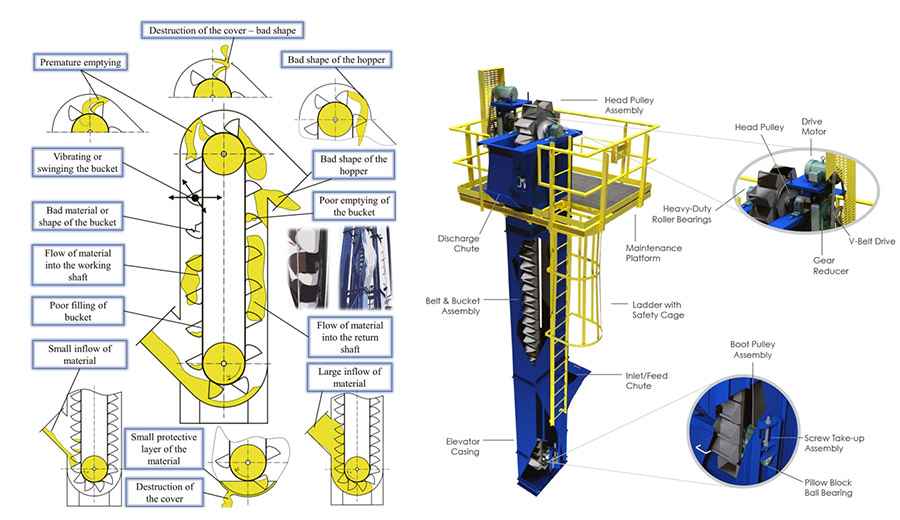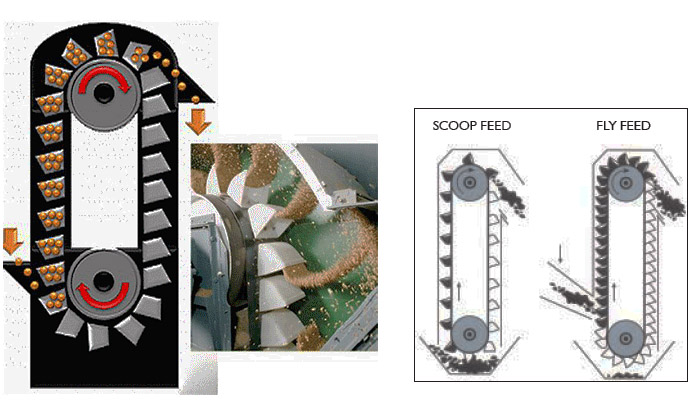How Does the Continuous Bucket Elevator Work?
Saturday March-15 2025 16:24:57
A Continuous Bucket Elevator is a type of vertical conveying equipment designed to handle bulk materials such as grains, powders, and granules. It is widely used in industries like agriculture, mining, and manufacturing due to its efficiency and gentle handling of materials. Below is a detailed explanation of its working principles, structure, and applications.
1. Structure of a Continuous Bucket Elevator
The continuous bucket elevator consists of the following key components:

Buckets: These are attached to a belt or chain in a closely spaced or overlapping arrangement. The buckets are designed with a shallow, open shape to allow smooth material flow.
Belt or Chain: The buckets are mounted on a continuous loop of belt or chain, which moves them vertically.
Drive System: A motor powers the belt or chain, enabling the buckets to move upward and downward.
Inlet and Outlet: The inlet is located at the bottom for material loading, while the outlet is at the top for material discharge.
Casing: A protective enclosure surrounds the elevator to prevent dust and material spillage.
2. Working Principle
The continuous bucket elevator operates on the principle of gravity discharge and continuous material flow. Here’s how it works:

Material Loading:
Material is fed into the elevator through the inlet at the bottom.
The buckets scoop up the material as they pass through the loading zone.
Vertical Transport:The belt or chain moves the loaded buckets upward along the elevator casing.
The closely spaced or overlapping buckets ensure a continuous flow of material without gaps.
Material Discharge:At the top of the elevator, the buckets invert, allowing the material to slide out gently due to gravity.
The discharged material is directed to the outlet for further processing or storage.
Return Cycle:After discharging, the empty buckets return to the bottom to repeat the cycle.
3. Key Features and Advantages
Gentle Handling: The continuous design minimizes material degradation, making it ideal for fragile or lightweight materials like flour, sugar, or chemicals.
High Efficiency: The closely spaced buckets ensure a steady flow of material, reducing downtime and increasing throughput.
Low Maintenance: The simple design and robust construction result in fewer breakdowns and easier maintenance.
Versatility: Suitable for a wide range of materials, including powders, granules, and small lumps.
4. Applications
Continuous bucket elevators are used in various industries, including:
Agriculture: For transporting grains, seeds, and feed.
Chemical Industry: For conveying powders and granules.
Mining: For moving ores and minerals.
5. Comparison with Centrifugal Bucket Elevators
Feature| Feature | Continuous Bucket Elevator | Centrifugal Bucket Elevator |
| Bucket Design | hallow, open buckets | Deep, scoop-like buckets |
| Discharge Mechanism | Gravity-based, gentle discharge | Centrifugal force, high-speed discharge |
| Material Handling | Fragile, lightweight materials | Durable, abrasive materials |
| Speed | lower, smoother operation | Faster, more aggressive operation |
The continuous bucket elevator is a reliable and efficient solution for vertical material handling, especially for fragile or lightweight materials. Its gentle discharge mechanism and continuous flow design make it a preferred choice in industries requiring careful material handling. For more detailed technical specifications or custom solutions, consult manufacturers or industry experts
Recommend Product
- Bucket Elevator
- Bucket Elevators Manufacturers
- Continuous Bucket Elevator
- Centrifugal Bucket Elevator
